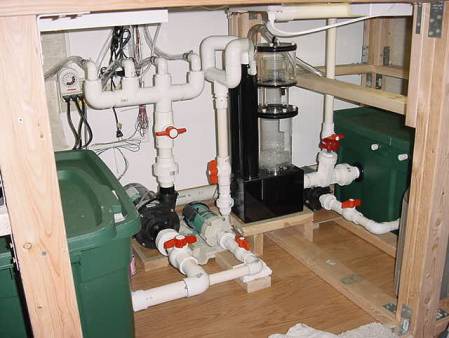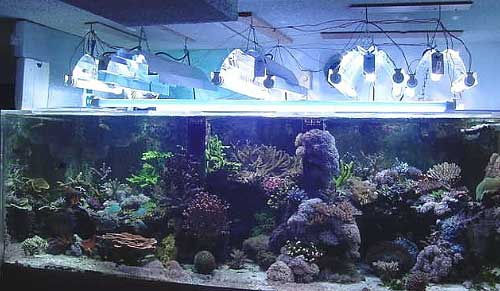|
Kevin Pockell's (kevinpo) Reef Aquarium
Introduction and Background:
I
started keeping freshwater fish as a child, and raised African
cichlids and Discus as a young adult in the mid-'70's. I would
see the beautiful saltwater fish at the local fish stores
and think that someday I would give it a try. I bought a 100-gallon
tank in 1977 and told myself I would set it up only for saltwater.
I kept it through several moves, hauling it in and out of
several homes before finally setting it up in 1985. After
nearly 20 years and several more tanks I must admit, I'm definitely
hooked for life
I don't believe there is any one right way
to assemble a reef tank. I have been successful with several
methods. The tank featured here has been running since June
of 2001 and has dimensions of 96"x 44"x 33.5"
with a volume of 557 gallons. A sump/refugium holds an additional
95 gallons. The majority of my corals have come from other
hobbyists, starting as small 1-3" frags. It's my belief
that captive propagation is the future of the coral collection
hobby.
System Design:
The system was designed
to be as maintenance-free as possible because I would typically
travel for roughly three weeks each month. The tank was originally
designed to be a room divider viewable from both sides, but
due to problems with removing the wall it was placed in the
corner. That is why the two overflow towers are located in
the center rather than on the back wall. The overflows are
3.5" square (inside dimension). They were supposed to
be 4" to accommodate a 2" bulkhead but due to a
manufacturer's error I had to use 1.5" bulkheads. This
resulted in the water level running quite high. In retrospect
a closed loop system would have been a great feature. I can
always add that on my next tank when I upgrade.
Top middle section of the tank.
Aquascaping:
I have about 800 lbs.
of live rock placed in the center of the tank resulting in
a double-sided reef. There are several locations where large
fish can swim through the rockwork. I believe this design
has helped reduce aggression between the fish as it allows
them to be out of sight of each other. It also provides twice
the grazing space and unobstructed flow behind the rocks.
Bottom left section of the tank.
|
Top left section of the tank.
|
Top right section of the tank.
|
Side view of the tank.
Equipment:
I made the stand from
2 x 4's, 4 x 4's, deck screws, and galvanized brackets purchased
at the local Home Depot. The reason I chose this method is
that it allows me to completely disassemble and move the stand.
Since it needed to be very sturdy, it became too heavy and
bulky to move in one piece.
 |
-
The pump on the left (above) is a Dolphin Aqua
Sea 4500. It is the main circulation device. It feeds
four 3/4" Sea Swirls and can deliver 3600 GPH @ 5'
head.
-
The next pump to the right is an Iwaki MD55RLT to power
the Gemini ETSS 800 skimmer.
-
The pump on the far right (barely noticeable between
the skimmer and right side of the sump) is an Iwaki MD100RLT,
which returns water from the sump through the end of the
tank at the water's surface to provide surface gas exchange.
It delivers 2000 GPH @ 4' head.
-
This is the Korallin C3002 calcium reactor (above
left). My system's calcium level runs 380-420 ppm.
I would recommend using a reactor to anyone keeping a
large amount of SPS corals. I added a second chamber built
by Geo because the single chamber could not keep up with
the demand for calcium. Additionally, I run a kalkwasser
reactor (seen on the right).
-
This is the new sump/refugium (above) that I installed
on 8-24-02. It has a 112 gallon capacity, measures 40"
x 36" x 19" and is lit by two 110 watt VHO 50/50
bulbs. It was custom-made by Barr Aquatics.
-
The skimmer (above) is a Barr Aquatic SK4200 powered
by an Iwaki MD100RLT (I run both skimmers simultaneously).
The other picture is a Barr Aquatic kalk reactor that
treats my 12-14 gal a day of RO/DI make-up water.
 |
-
The lighting consists of five 400-watt metal halide bulbs,
three Ushio 10,000K and two Radium 20,000K bulbs driven
by PFO brand HQI type ballasts. For the dawn/dusk effect
there are eight 95 watt and two 160 watt URI VHO actinic
bulbs driven by IceCap and URI electronic ballasts. So I
have 1080 watts of actinics and 2000 watts of halides for
3080 total watts. The 10,000K halide bulbs are placed on
the outsides and one in the center with the 20,000K's positioned
in between. The halides are on for nine hours. The 160-watt
actinic bulbs run for 14 hours and the 95-watt actinics
run for 12 hours.
Acropora microphthalma - my biggest coral.
Husbandry & Maintenance:
I change 150 gallons
of water every 3-4 weeks using RO/DI water. Some of the challenges
as the tank has aged have been:
-
Keeping the corals from overgrowing and fighting with
each other (see below).
-
Providing enough flow as the corals grow and begin
to block and change the flow patterns.
-
Keeping algae at manageable levels.
-
Keeping up with coralline algae removal on the front
and end panels.
Corals at war!
Feeding:
I make a chopped preparation
that I keep in an old Cool Whip container stored in the freezer
that consists of:
The first four ingredients are of equal proportions with
one-teaspoon of garlic added to them.
Water Chemistry/Water Parameters:
|
I test only
specific gravity, calcium and alkalinity levels with
average results of:
|
|
Water
Parameters:
|
·
Calcium: 397 ppm
|
|
·
Alkalinity: 2.94 meq/L
|
|
·
Specific Gravity: 1.025
|
|
|
Supplements/Additives:
For the first 18 months
I did not have to add anything but as the calcium consuming
corals grew large I began to dose calcium chloride and buffer.
Growth of the reef as seen in a series of photos beginning
with 2002 at the top
and ending with 2004 in the bottom shot.
Filtration:
I use protein skimming
and live plants in the refugium for filtration. I also run
ozone and carbon.
Inhabitants:
The Mandarinfish,
Anthias, Chromis, Clownfish, and Triggers have all spawned.
No attempts were made to collect the eggs or raise the fry.
|
Fish:
|
|
10
Lyretail Anthias
(Pseudanthias squamipinnis)
9/7/02
|
Sixline
Wrasse
(Pseudocheilinus hexataenia) 7/7/01
|
|
Sailfin
Tang
(Zebrasoma desjardinii) 11/12/01
|
Purple
Tang
(Zebrasoma xanthurum) 3/6/99
|
|
Mated
pair of Bluejaw Triggers
(Xanthichthys auromarginatus)
1/5/03
|
Two
Green Chromis
(Chromis atripectorails) 7/7/01
|
|
Naso
Tang
(Naso lituratus) 7/17/01
|
Lawnmower
Blenny
(Salarias fasciatus) 7/18/02
|
|
Blueface Angel
(Pomacanthus xanthometopon) 8/3/02
|
Copperband
Butterflyfish
(Chelmon rostratus) 8/16/02
|
|
Chalk
Bass
(Serranus tortugarum) 9/25/02
|
Royal
Gramma
(Gramma loreto) 2/17/96
|
|
Mated
pair of Green Mandarinfish
(Synchiropus splendidus)
8/8/01
|
Pinkspotted
Shrimp Goby
(Cryptocentrus leptocephalus) 11/20/98
|
|
Two
Scissortail Dartfish
(Ptereleotris evides) 11/29/02
|
False
Percula Clownfish
(Amphiprion ocellaris) 2/1/96
|
 |
|
Corals:
|
|
Acropora:
Acropora abrolhosensis, A. aculeus, A. austere, A.
cerealis, A. chesterfieldensis, A. cytherea, A. formosa,
A. gemmifera, A. grandis, A. humilis, A. loisetteae,
A. loripes, A. lovelli, A. microphthalma, A. millepora,
A. nana, A. nobilis, A. prostrata, A. pulchra, A. robusta,
A. sarmentosa, A. secale, A. solitaryensis, A. tenuis,
A. tortuosa, A. valida, A. yongei
|
|
Leptoseris
hawaiiensis
|
Stylophora
pistillata
|
|
Heliopora
coerulea
|
Hydnophora
grandis
|
|
Favites
sp.
|
Nemenzophyllia
turbida
|
|
Porites
cylindrical, P. porites
|
Pocillopora
damicornis, P. verrucosa
|
|
Euphyllia
ancora, E. glabrescens
|
Seriatopora
caliendrum, S. hystrix
|
|
Galaxea
fascicularis
|
Turbinaria
reniformis
|
|
Platygyra
acuta
|
Gorgonia
mariae
|
|
Montipora
capricornis, M. digitata, M. confusa, M. spongodes
|
|
Xenia
umbellata
|
Pink Table Coral (Acropora hyacinthus) - Growth over
a year.
Acropora loripes - Growth over four years.
|
|
September
2001
|
|
|
October
2002
|
|
|
June
2003
|
|
|
October
2004
|
|
|
|
November
2001
|
|
|
January
2002
|
|
|
May
2003
|
|
|
Invertebrates:
|
|
Three
cleaner shrimp
|
Tonga
conch
|
|
Blue Linckia starfish
|
Various
snails
|
|
Heteractis
crispa
anemone
|
Tridacna
derasa, T. gigas, T. maxima, T. squamosa
|
|
Lettuce slug (Elysia crispata)
|
Hermit
crabs (hitchhikers)
|
Acknowledgements:
I want to thank Reef
Central and the people there who have helped and inspired
me over the years. What a wonderful resource for the beginner
or experienced hobbyists.
Thank you very much,
Kevin
Feel free to comment or
ask questions about my tank in the Tank of the Month thread
on Reef Central.
|

